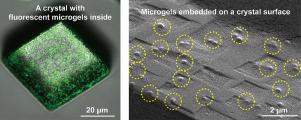Giant ( IF 5.4 ) Pub Date : 2020-08-16 , DOI: 10.1016/j.giant.2020.100023 Xinyi Jin , Jinqiao Xue , Dong Hee Kang , Yujing Liu , Jie Ren , Quan Wen , Dapeng Hu , Yan Yu , Wei Yang , Binyang Du , Myung-Han Yoon , Hanying Li

|
Single crystals have been shown to incorporate guest materials (e.g., gel networks and functional particles) and the incorporated materials endow the crystal hosts with non-intrinsic properties. The acquisition of the non-intrinsic crystal properties impels us to diversify the incorporated guest materials and thus to spread the potential applications of single-crystalline materials. Here, fluorescent NIPAM-based microgels have been selected as the guest materials to be incorporated into the crystal hosts. In the presence of microgels, calcite crystallize from either solution or gel media have been examined. Solution-grown crystals exclude the microgels, while two gel-grown methods have proved effective for incorporating these microgels inside calcite single crystals. On one hand, an additional macroscopic agarose gel-network is introduced to trap the microgels. Crystallization in the agarose gel leads to incorporation of agarose gel-network together with the trapped microgels. The microgel concentration in the crystal reaches 33 mg/mL. On the other hand, dispersions of microgels are concentrated to about 352 mg/mL and the microgels aggregate into non-flowing macroscopic gels (termed as macrogels). Crystallization in a macrogel results in its incorporation. By showing the incorporation of microgels through physical entrapment, this work provides a new platform to functionalize single crystals by the microgels.
中文翻译:

在方解石单晶内掺入荧光微凝胶
已显示单晶结合了客体材料(例如,凝胶网络和功能颗粒),并且所结合的材料赋予晶体主体非内在的特性。非本征晶体性质的获得促使我们使掺入的客体材料多样化,从而扩展了单晶材料的潜在应用。在此,已经选择了基于荧光NIPAM的微凝胶作为要掺入晶体主体的客体材料。在存在微凝胶的情况下,已经检测到方解石从溶液或凝胶介质中结晶出来。溶液生长的晶体排除了微凝胶,而两种凝胶生长的方法已被证明可以有效地将这些微凝胶掺入方解石单晶中。一方面,引入了另一种宏观琼脂糖凝胶网络以捕获微凝胶。琼脂糖凝胶中的结晶导致琼脂糖凝胶网络与捕获的微凝胶一起掺入。晶体中的微凝胶浓度达到33 mg / mL。另一方面,将微凝胶的分散体浓缩至约352mg / mL,并且微凝胶聚集成不流动的宏观凝胶(称为大凝胶)。大凝胶中的结晶导致其结合。通过展示微凝胶通过物理包埋的结合,这项工作提供了一个新的平台,可通过微凝胶功能化单晶。将微凝胶分散液浓缩至约352 mg / mL,并将微凝胶聚集成非流动的宏观凝胶(称为大凝胶)。大凝胶中的结晶导致其结合。通过展示微凝胶通过物理包埋的结合,这项工作提供了一个新的平台,可通过微凝胶功能化单晶。将微凝胶分散液浓缩至约352 mg / mL,并将微凝胶聚集成非流动的宏观凝胶(称为大凝胶)。大凝胶中的结晶导致其结合。通过展示微凝胶通过物理包埋的结合,这项工作提供了一个新的平台,可通过微凝胶功能化单晶。











































 京公网安备 11010802027423号
京公网安备 11010802027423号